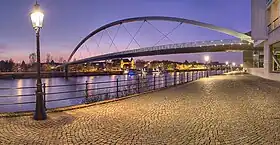Hoge Brug / Hoeg Brögk | |
|---|---|
 The Hoge Brug, viewed from the Céramique area on the eastern bank of the Maas | |
| Coordinates | 50°50′46″N 5°41′50″E / 50.8462°N 5.6973°E |
| Carries | Pedestrians and bicycles |
| Crosses | Meuse |
| Locale | Maastricht (Binnenstad–Wyck/Céramique) |
| Preceded by | John F. Kennedybrug |
| Followed by | Sint Servaasbrug |
| Characteristics | |
| Design | Arch bridge |
| Total length | 261 meters [1] |
| Width | 7.2 meter [1] |
| Height | 10 meters (bridge) / 26 meters (highest point of arch) [1] |
| History | |
| Designer | René Greisch |
| Opened | 2003 |
| Location | |
The Hoge Brug (Dutch for "high bridge", also known by its Maastrichtian dialect name: Hoeg Brögk) is a pedestrian and cycle bridge that spans the Meuse (Dutch: Maas) in Maastricht, Netherlands.
Gallery
 Entrance to the Hoge Brug on the eastern bank of the Meuse.
Entrance to the Hoge Brug on the eastern bank of the Meuse. View of the Céramique section of Wyck (eastern Meuse bank) taken from the bridge.
View of the Céramique section of Wyck (eastern Meuse bank) taken from the bridge. View of the Hoge Brug from the eastern Meuse bank.
View of the Hoge Brug from the eastern Meuse bank.
References
- 1 2 3 Hoge Brug Maastricht wint Staalprijs 2004. 15 oktober 2004, nieuwsbank.nl
This article is issued from Wikipedia. The text is licensed under Creative Commons - Attribution - Sharealike. Additional terms may apply for the media files.
